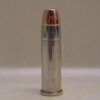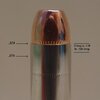I've shot hundreds, if not thousands of that style of bullet through my Coonan. If there was ever a gun that would walk a bullet, it would be that Coonan, as it doesn't even start to run right until you are running a max load, especially lighter bullets. The .357 Lee FCD is a roll crimp die, not a taper crimp, for revolver cartridges (it's a taper crimp for pistols). It will crimp just fine without a cannelure. I've run plenty just using a standard die die set, and crimped with a standard RCBS crimp/seat die.....and they all ran just fine, but years ago I switched to crimping in a separate station as it just plain results in better ammo. You don't "need" to use a fcd, and those bullets will work just fine with a standard crimp/seat die....but you'll be doing yourself a favor in the long run if you grab a separate die to crimp with, and the Lee FCD is a good one. I personally prefer to buy bullets without the cannelure because I don't always want to seat them at the depth the bullet company decided I should.




